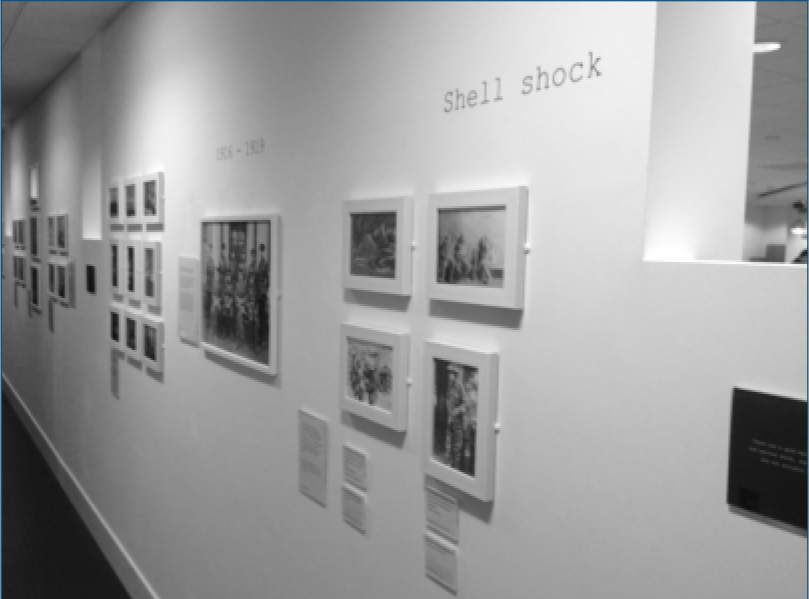
A photograph of the exhibition at the College taken by the author.
War has contributed immensely to our discovery, understanding and advancing of treatments for post-traumatic stress disorder (PTSD). This exhibition aimed to showcase the influence of the then Maudsley Neurological Clearing Hospital in relieving the mental suffering of soldiers during the First World War.
Sir Frederick Mott (1853–1926) was a war-time psychiatrist who is less well known than Henry Maudsley (1835–1918), but from this exhibition it is clear that he worked tirelessly to manage the different presentations of what was then referred to as shell shock. He believed in diversion of the mind as a treatment principle. Injured soldiers were encouraged to focus on therapeutic activities and away from their experiences of war in order to promote healing. Mott also believed in the vital contribution of a structured, managed external environment to aid the healing process. This involved recreation activities and spaces, colours of bedrooms, nutritious food and rest so as to promote an ‘atmosphere of cure’. The hospital had a gymnasium where soldiers used parallel bars, climbing and skipping ropes, etc. Sir Frederick persuaded benefactors to support occupational workspaces where soldiers took part in activities including carpentry, gardening and book-binding.
This Hospital had enormous reach. The British Army reported over 80 000 cases of shell shock during the First World War and at least 12 400 are thought to have been treated there. Initially, it had 144 beds but this expanded to 450 by 1917. The soldiers experienced symptoms such as sleep paralysis, nightmares, palpitations, fatigue, functional paralysis. The official position was to restore them to health and send them back to the war front but we are informed by the exhibition that only about 25% returned.
Mott's use of diversion of the mind is reminiscent of current treatment modalities of creating or managing dissociation in the management of severe manifestations of PTSD, conversion and somatoform disorders. His ideas of an ‘atmosphere of cure’ is mirrored in treatments today. We continue to use structured living spaces in intellectual disability and forensic psychiatry. It is also what we try to create in psychodynamic therapy. There is also increasing use of nidotherapy in the management of severe mental disorders. It is interesting that even at that time, it was believed (Howard Kemp-Prosser) that bedrooms painted in certain colours were more restorative to the mind. The treatments were holistic, encompassing diet and work. We are becoming curious again about how diet may aid recovery from mental illness. What was missing from this exhibition are details of therapies or medications used in managing these soldiers. Pictures of equipment would have been an interesting addition.
These sorts of illnesses and symptoms still continue to plague our society. We know more about them today but provision of services, access to treatments and funding for research continue to be insufficient. Patients who experience today what we may call medically unexplained symptoms often suffer from lack of clear and coherent treatment pathways. Government investments have not addressed these as seriously as policies had intended. The exhibition illustrates that management of these disorders was and still is resource intensive. Then and now, it requires multidisciplinary, collaborative and stepped care.
The exhibition closed on 20 November 2016.





eLetters
No eLetters have been published for this article.